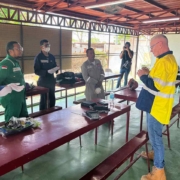Overcoming Language Barriers: Effective Communication in Multinational Teams
In today’s globalised business environment, multinational teams are becoming the norm. While these teams bring diverse perspectives and skills, they also face the challenge of language barriers. Effective communication is crucial in any team, but in a multinational context, it becomes a linchpin for success. In this article, we’ll explore practical tips and techniques for overcoming language barriers, enhancing collaboration and understanding within multinational teams.
The Impact of Language Barriers
A study by the Economist Intelligence Unit revealed that 49% of 572 senior executives believed misunderstandings and miscommunication due to language differences had led to significant inefficiencies in their organisation. Language barriers can lead to misinterpretation of information, delays in project execution, and even affect employee morale. Thus, addressing these barriers is not just about improving communication; it’s about enhancing overall team performance and productivity.
8 Simple Strategies for Overcoming Language Barriers
1. Encourage Language Learning
Fostering an environment where team members are encouraged to learn new languages can be immensely beneficial. Tools like Duolingo or Rosetta Stone offer accessible language learning platforms. Even basic proficiency can go a long way in breaking down communication barriers.
2. Use Clear and Simple Language
When communicating with team members who speak different languages, it’s important to use clear, simple language. Avoiding slang, idioms, and complex jargon can make communication more accessible. In many Asian countries, sarcasm is also little understood, which can turn what was meant as a joke into a sour grudge. The Harvard Business Review emphasises the importance of clarity in multinational team communication.
3. Leverage Technology
Technology can be a powerful ally in overcoming language barriers. Tools like Google Translate or Microsoft Translator can aid in real-time translation and understanding. Moreover, collaboration tools like Slack or Microsoft Teams offer translation features for seamless communication.
4. Visual Aids and Demonstrations
Visual communication can transcend language barriers. Using diagrams, flowcharts, or even physical demonstrations can convey messages more effectively than words alone. A study by 3M Corporation and Zabisco found that visuals are processed 60,000 times faster in the brain than text, highlighting the power of visual aids in communication.
5. Regular Check-ins and Feedback
Regular check-ins and feedback sessions help ensure that all team members are on the same page. These sessions provide opportunities to clarify misunderstandings and address any communication issues promptly.
6. Cultural Sensitivity Training
Understanding the cultural nuances that accompany language is equally important. Providing cultural sensitivity training can enhance team members’ ability to communicate more effectively and respectfully with colleagues from different backgrounds.
7. Professional Interpreters and Translators
In critical situations or important meetings, employing professional interpreters or translators can be invaluable. They ensure accurate and effective communication, especially in complex or technical discussions.
8. Patience and Empathy
Creating a team culture where patience and empathy are valued is fundamental. Encouraging team members to be patient with language learners and showing empathy towards communication challenges fosters a supportive environment.
Case Studies and Success Stories
Many multinational corporations have successfully navigated language barriers to build effective teams. For instance, companies like Nokia and Rakuten have implemented English as a common corporate language, with support systems for non-native speakers.
Overcoming language barriers in multinational teams is a multifaceted challenge that requires a combination of strategies. By encouraging language learning, leveraging technology, using visual aids, and fostering a culture of patience and empathy, teams can enhance their communication and collaboration. The benefits of these efforts extend beyond just improved communication; they lead to more cohesive, innovative, and productive teams.
As the leading offshore recruitment agency in the Philippines, Macati remains committed to supporting our clients and candidates in building effective multinational teams, recognising that clear communication is the cornerstone of successful international collaboration.
References:
- “Lost in Translation,” Economist Intelligence Unit.
- Harvard Business Review on multinational team communication.
- 3M Corporation and Zabisco on visual communication.

 Macati Recruitment
Macati Recruitment Macati Recruitment
Macati Recruitment Macati
Macati Macati
Macati Macati Recruitment
Macati Recruitment Macati
Macati Macati Recruitment
Macati Recruitment